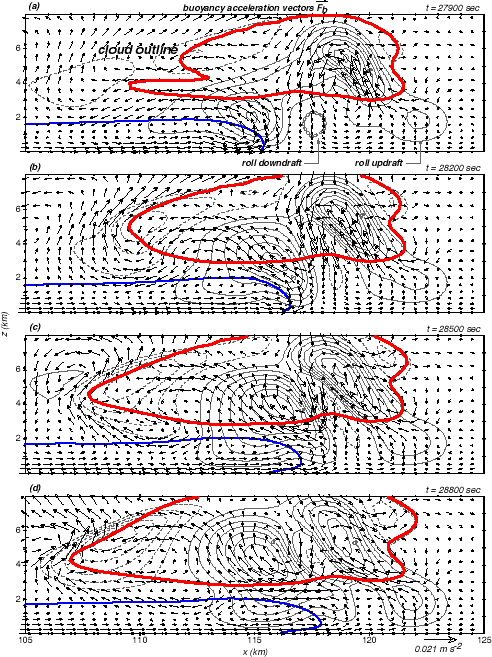
|
Outline |
|---|
|
The intermediate stage: forcing of the interior cloud downdraft |
|---|
During the period in which the two strong updrafts reside within the common cloud shield, a strong midcloud downdraft appears briefly in between. The analysis of this downdraft is now discussed.
The figure below focuses in on the strong downdraft's development period. Again, the two strong updrafts (grey contours) are seen growing within the cloud shield. The arrows depict not velocity but rather the instantaneous total buoyancy acceleration. These vectors show where air is being accelerated by the combination of the buoyancy force and the buoyancy pressure gradient. Please refer to this discussion for more information. (This link opens in a new window.)

The next figure animates the fields depicted above, and provides perhaps the best view of how the SBF propagation speed rebounds and how assimilation of the HCR commences. Here, the red contours are vertical velocity and cloud water content is shown in blue. The animation leads into the late stage, which is covered in the paper.
|
Summary of the three stages |
|---|
Each of the encounters of the SBF with roll vortices is unique. The intermediate stage is certainly the most dramatic and stresses the importance of the circulations induced by SBF and HCR clouds. Yet, in each stage, the modulation of the environment into which the SBF is propagating plays a critical role in the evolution of the front and frontal convection. The propagation speed, intensity of frontal lifting, and the character of frontal cloudiness can all be tied to the evolution of the front in the presence of HCRs. At the same time, the "background circulation" induced by the SBC impacts HCRs developing in its upstream environment. In this way, it is a distinctly two-way interaction, both features exhibiting characteristics that do not exist when they develop independently.
Page created February, 2000, by
![]() Robert Fovell
Robert Fovell